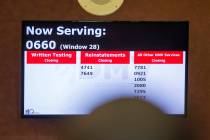If at first you don’t succeed, keep asking voters for appellate court
The 2013 session of the Nevada Legislature got down to business Tuesday, after a day of ceremonial speeches and formalities. The first action of the Senate Judiciary Committee? Ignoring Nevada voters, who in 2010 refused to create an intermediate state appellate court, 53 percent to 47 percent.
On Tuesday, the panel passed Senate Joint Resolution 14 — to set up by constitutional amendment the very same court voters rejected — and forwarded it to the full Senate. The measure is on track to appear on the ballot in 2014.
Supreme Court Justice James Hardesty told senators the appeals court would cost about $1.7 million a year, mostly for the salaries of three judges, clerks and staff. The new court would use shared quarters in existing court buildings, he said. The goal is to have the new appeals court handle 700 to 800 cases per year, denying most of those appellants the right to appeal to the Supreme Court, thus reducing the high court’s workload to about 1,600 to 1,800 cases per year.
Proponents point out that Nevada is one of only 11 states without such an appellate court, and they insist that expanding the system will help speed up individual cases while giving the Supreme Court more time to consider substantive matters. The plan certainly has merit. This newspaper endorsed Question 2 in 2010. Population growth in this state has strained the judiciary and its ability to resolve criminal and civil matters in a timely fashion.
But voters obviously have concerns about the costs of adding another layer to the judiciary. They’ve rejected this proposal three times already. The new court won’t even need its own building? They’ve heard that one before. Maybe voters believe the high court isn’t as efficient as it could be. Maybe they believe judges aren’t killing enough frivolous lawsuits.
Regardless of their motives, Nevadans have made it clear they don’t favor creating a three-judge court to act as a buffer between the nine District Courts and the Supreme Court.
At least the 2010 ballot question was 18 years removed from the previous effort. But if the current Senate resolution passes the Assembly and gets the governor’s signature, just four years will have elapsed between ballot measures. Do lawmakers hope Nevadans will approve the thing just so they won’t have to look at it anymore?
All involved show a lack of respect for the judgment of Nevadans who took the time to render their verdict on this issue a mere two years ago. Other than the fact that government is even less affordable today, what do they think has changed?























